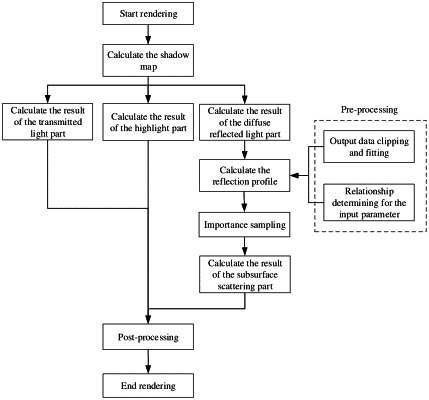| CPC G06T 15/506 (2013.01) [G06T 15/30 (2013.01)] | 4 Claims |

|
1. A subsurface scattering calculation method for translucent material rendering, comprising:
step 1: using Monte Carlo photon tracker MCML, defining input file parameters as an upper, middle and lower three-layer object, considering anisotropy using a similarity theory, clipping an output data to avoid an influence of zero value data on a fitting error, and fitting the clipped data with a specific polynomial function, to obtain several groups of fitting results, in which upper and lower layers of the upper, middle and lower three-layer object are air layers, a middle layer of the upper, middle and lower three-layer object is a measurement layer, a refractive index η is set to 1 to avoid an influence of the refractive index, and, an anisotropy parameter g is set to 0;
step 2: through the several groups of fitting results obtained in step 1, using input parameters to determine a relationship of unknown terms in the polynomial; based on a selected fitting polynomial, determining a molecular coefficient term, a molecular constant term and a denominator constant term respectively to obtain a reflection profile calculation formula, wherein, the input parameters are a total diffuse reflectance considering a selected object surface, and an average free path of an object material, based on an artist friendliness;
step 3: according to the reflection profile calculation formula obtained in step 2, calculating a cumulative distribution function cdf for the reflection profile calculation formula, and inversing the cdf to obtain an importance sampling formula, wherein, there is no numerical solution for the inverse of cdf, which is approximately solved by way of fitting, the importance sampling formula does not depend on a specific profile calculation formula, the importance sampling formula is related to the average free path and a single scattering rate;
step 4: in an operation stage, based on the reflection profile calculation formula obtained in step 2 and the importance sampling formula obtained in step 3, sampling several sample points in a screen space, and using Monte Carlo to calculate an outgoing radiation of a subsurface scattering influence part of object surface points;
step 5: mixing the subsurface scattering influence part with a highlight influence part and a transmitted light influence part, and carrying out subsequent post-processing steps to realize final rendering of translucent objects.
|